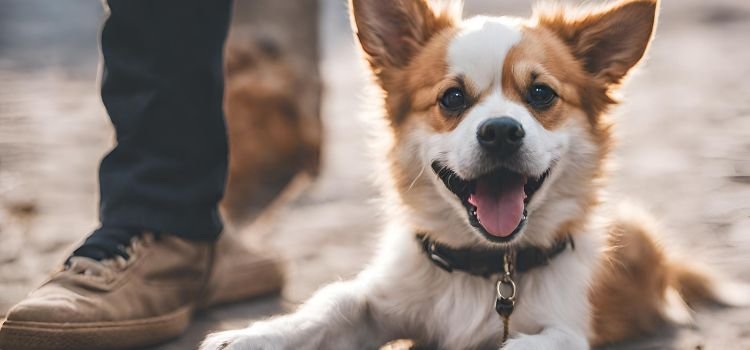As an Amazon Associate committed to the mission of improving the lives of our readers, Live-Clear.com receives a small commission from eligible purchases made through our affiliate links. This revenue enables us to keep producing insightful articles and other material.
Dogs talk back to their owners as a form of communication and attention-seeking behavior. This behavior is often an indication of their desire to engage with their owners and communicate their needs.
Dogs are social animals that crave attention, love, and affection. For this reason, they seek interaction with their humans. Talking back can come in various forms, from barks and growls to howls and whimpering. Some dogs may also mimic their human’s speech or vocalizations.

Dog owners can encourage positive communication by paying attention to their dogs’ needs, engaging them in play, and providing proper training and socialization. Recognizing the reasons behind a dog’s talk back behavior can lead to better communication and a stronger bond between dog and owner. We’ll explore why dogs talk back, how to train and communicate effectively with them, and ways to strengthen the human-canine relationship.
Why Do Dogs Talk Back?
It’s no secret that dogs love to communicate with their humans, whether it’s through wagging their tails, barking, or even talk back. Many dog owners might be surprised to hear their furry friends talk back, mimicking their own sounds and expressions.
Vocal Communication In Dogs
Before we dive into why dogs talk back, it’s important to understand how they communicate. Dogs use a variety of vocalizations, body language, and facial expressions to convey their thoughts and emotions to humans and other animals.
Why Some Dogs Talk Back
While not all dogs talk back, some breeds are more prone to it than others. For example, breeds such as Huskies and Malamutes are known for being talkative dogs that will try to engage with their humans through a variety of sounds and vocalizations. Additionally, dogs that have been trained using positive reinforcement may be more likely to talk back, as they have learned that certain behaviors can elicit a response from their humans.
Factors Affecting Talking Back In Dogs
Just like humans, dogs are individuals with their own personalities and tendencies, and there are several factors that can affect whether or not a dog will talk back. These include:
- Breed
- Training
- Personality
- Attention seeking behavior
It’s important to note that talking back is a natural behavior for some dogs and shouldn’t be punished. Instead, it can be a fun way for dogs and their humans to bond and communicate.
Understanding Your Dog’s Body Language
Understanding your dog’s body language is crucial in determining why your furry friend talks back to you. Dogs communicate through their body movements and vocalizations, and their gestures can reveal their mood or intentions. Knowing how to read your dog’s body language can improve communication and strengthen your bond with your pet.
Recognizing Dog Body Language
Dogs are intelligent creatures that express themselves in unique ways. They bark, wag their tails, growl, and make unusual sounds when they want to communicate. However, if you want to understand why your dog talks back, the first step is to recognize their body language. Your dog’s body language includes vocalizations, facial expressions, and physical movements. These are signals your dog uses to convey their emotional state, intentions, and needs.
Signs Your Dog Is Talking Back
Dogs are social animals and enjoy interacting with humans. When they talk back, it’s often due to boredom, lack of attention, or a desire to play. So, how can you tell if your dog is talking back? Some of the most common signs include growling, barking, whimpering, and whining. Your dog may also jump on you, nudge you with their nose, or paw at you in an attempt to communicate. It’s essential to understand your dog’s body language and recognize these signs to respond to your dog accordingly.
Interpreting Dog Body Language
Understanding your dog’s body language can help you interpret their behavior and prevent misunderstandings. For example, if your dog is growling and showing their teeth, it could indicate that they are feeling threatened or scared. Similarly, if your dog is barking loudly and jumping around, it could be a sign that they want to play.
By interpreting your dog’s body language, you can respond appropriately and meet their needs. Overall, communicating with your dog is crucial, and understanding their body language is the key to building a strong bond with them.

Training Your Dog To Stop Talking Back
If your dog talks back to you, it may be a sign of disrespect or a lack of training. Training your dog to stop talking back involves practicing commands and providing consistent discipline. Be patient and use positive reinforcement to show your dog what respectful behavior looks like.
Does your furry friend talk back when you give them commands? Is excessive barking becoming an issue in your household? Teaching your dog to stop talking back is an important part of training, and it can be achieved through positive reinforcement techniques.
Positive Reinforcement Training
Positive reinforcement is a training technique that rewards good behavior. When your dog listens to your commands, reward them with treats or praise. This method encourages your dog to learn and reinforces positive behavior. It’s important to note that positive reinforcement needs to be immediate. If you wait too long to reward good behavior, your dog won’t understand why they’re being rewarded. Consistency is key with positive reinforcement training.
Teaching Your Dog To Listen
Teaching your dog to listen to your commands is crucial in stopping excessive talking back. Start training with simple commands such as ‘sit’ or ‘stay’ and gradually move on to more complex ones. Use hand signals or verbal cues to reinforce your commands. Make sure to train your dog in a distraction-free environment, and gradually increase distractions as they become more responsive to your commands. Remember to remain patient and consistent in your training.
Discouraging Excessive Talking Back
Discouraging excessive talking back requires that you do not reinforce the behavior. When your dog starts barking or talking back, ignore them until they stop. Do not reward negative behavior with attention. If your dog continues to talk back, use a firm ‘no’ command or a quick, sharp noise such as a clap or whistle to interrupt their behavior. This will communicate to your dog that their behavior is not acceptable.
Training your dog to stop talking back requires patience, consistency, and positive reinforcement. Remember to reward good behavior, teach your dog to listen, and discourage negative behavior. With time and consistency, your furry friend will be a well-behaved, obedient companion.

Tools And Resources For Dog Owners
Having a dog can be a great source of joy and companionship. However, when your furry friend begins to talk back to you, it can be challenging to understand what’s going on. Fortunately, there are many tools and resources available for dog owners that can help you better communicate with your pet. In this article, we’ll explore some of the most effective ways to work with your dog to improve your communication and build a stronger bond.
Working With A Professional Dog Trainer
One of the best ways to tackle any communication issues with your dog is to work with a professional dog trainer. A good trainer will be able to observe your dog’s behavior and help you understand what they are trying to communicate. They can also teach you techniques for positive reinforcement to help shape your dog’s behavior and improve your communication with them.
Using Training Aids And Tools
Another effective way to improve communication with your dog is to use training aids and tools. These can include things like clickers, collars, and treats, which can help reinforce specific behaviors you are trying to encourage in your dog. There are also many different types of training aids and tools available online, so it’s easy to find something that will work for you and your dog.
Joining Online Dog Owner Communities
Finally, one of the best resources for dog owners is to join an online dog owner community. These communities are made up of people who share a love of dogs and can offer advice, support, and encouragement when you need it most. Whether you have a specific question or just want to connect with other dog owners, these communities can be an invaluable resource for building a stronger bond with your furry friend.
Overall, there are many different tools and resources available for dog owners who want to improve their communication with their pets. Whether you choose to work with a professional trainer, use training aids and tools, or connect with other dog owners online, the key is to stay patient, consistent, and positive when working with your dog.

Common Mistakes Dog Owners Make
As a dog owner, it’s likely that you’ve had moments where you’ve found yourself talking to your canine companion, only to receive a sudden response. While you may find this amusing or endearing, it can be a sign of an underlying issue that needs to be addressed.
Ignoring Talking Back
One of the most common mistakes dog owners make when their dog talks back is to ignore the behavior. While it may be harmless, ignoring this behavior can lead to more serious issues down the road. Dogs, like people, require social interaction and communication. When they talk back, they are attempting to communicate with you and ignoring them can lead to frustration on both sides.
Using Negative Reinforcement
Another mistake that dog owners make when their dogs talk back is to use negative reinforcement. This can take many forms, including yelling, punishment, and physical discipline. While it may seem like the most logical course of action, negative reinforcement can actually exacerbate the problem. Instead, it’s important to reinforce positive behaviors through positive reinforcement techniques such as treats, praise, and affection.
Lack Of Consistency
A lack of consistency can also be a contributing factor to dogs talking back. Inconsistency can lead to confusion and frustration for your dog, as well as making it difficult for them to understand what is expected of them. It’s important for dog owners to establish clear rules and boundaries and consistently reinforce them. This will help your dog understand what is expected of them and minimize the likelihood of them talking back.
Ultimately, understanding why your dog talks back to you is critical to addressing the issue. By avoiding these common mistakes and consistently reinforcing positive behaviors, you can help your dog become a well-behaved, happy member of your family.

Conclusion
To wrap up, talking back is a common behavior among dogs that shouldn’t be neglected. Now that we have a better understanding of the possible reasons why your dog talks back, you can start addressing the issue. From establishing clear boundaries to seeking professional help, there are various approaches to help you and your furry friend communicate more effectively.
Frequently Asked Questions For Why Does My Dog Talk Back To Me
When a dog tries to ‘talk’ to you, it typically means they are communicating their emotions or needs through body language, whining, barking, or other vocalizations. Paying attention to your dog’s communication cues can help strengthen the bond between you and your furry friend.
When your dog talks back to you, the first thing to do is to stay calm and not give in. Then, try to understand why your dog is behaving this way and address any underlying issues. You can also train your dog to respond to certain commands and learn to communicate with it effectively through positive reinforcement.
Dogs can be very vocal with their owners because they use vocalization as their way of communicating. They may use barking, whining, growling, and howling to express their needs, wants, or emotions. It’s important for owners to understand their dog’s vocal cues to better meet their needs.
Yes, dogs can try to talk back through various vocalizations such as barking, whining, growling, and howling. They may also use body language and facial expressions to communicate with their owners. However, it’s essential to understand that dogs don’t actually speak human language, and these behaviors are simply their way of expressing themselves.
Dogs might talk back to their owners as a response to their behavior or tone of voice or to grab their attention.
With patience and persistence, you can build a strong and healthy relationship with your furry companion. Seeking professional help is also an option.
Amazon and the Amazon logo are trademarks of Amazon.com, Inc, or its affiliates.



